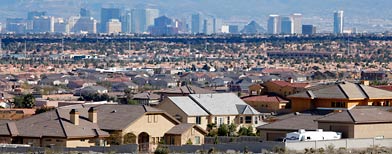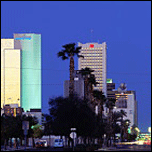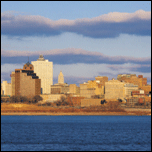 Negative equity–what you have when you owe more on your home loan than the property is worth–is one of the defining features of the still-unfolding mortgage crisis. It’s a particularly nasty problem because it can lead to all sorts of unpleasant outcomes for the real estate market and the economy as a whole.
Negative equity–what you have when you owe more on your home loan than the property is worth–is one of the defining features of the still-unfolding mortgage crisis. It’s a particularly nasty problem because it can lead to all sorts of unpleasant outcomes for the real estate market and the economy as a whole.
Having negative equity, which is also known as being “underwater” on a mortgage, makes homeowners more likely to end up in foreclosure. It restricts a borrower’s ability to refinance or buy another home, which in turn stifles demand for housing. It even reduces the flexibility of the labor market, since underwater homeowners are less willing to leave town to take a different job, says Stan Humphries, the chief economist at Zillow.
“We have never had negative equity like this at the national level in as many different regions as we have now,” Humphries says. To get a better sense of the cities with the greatest concentrations of negative equity, Zillow provided U.S. News with data that detail the percentage of mortgage borrowers who are underwater in 142 distinct markets throughout the country. Based on this research, we compiled the following list of America’s most underwater housing markets. (Please note: We chose no more than one city per state.)
1. Las Vegas
 |
Las Vegas was ground zero for the housing market’s historic boom and bust. Loose lending standards and speculative fervor helped send home prices surging more than 104 percent from 2002 to their 2006 peaks, according to Moody’s Economy.com.
“We all knew in our hearts it was unsustainable and there had to be a correction,” says Larry Murphy, the president of SalesTraq. That correction came as the housing bubble popped and the economy tanked: Home prices in Las Vegas fell more than 56 percent from 2006 to the third quarter of 2009. This steep decline has pulled a vast swath of mortgage borrowers underwater.
“If you bought a home in Las Vegas since 2004 up to about 2007, whatever you bought–I don’t care if you bought a big house or a little house, in a great neighborhood or a crummy neighborhood–it’s worth about half what you paid for it,” Murphy says.
More than 81 percent of single-family home mortgages in Las Vegas had negative equity in the fourth quarter of 2009, according to Zillow. And it may take 20 years for some of these home values to climb back to the levels they hit at the peak of the housing boom, Murphy says.
2. Merced, Calif.
The housing crisis that has rocked Merced, Calf., was initially linked to rising property values in relatively nearby metropolitan areas like San Francisco. As real estate became increasingly unaffordable in the bigger cities, many would-be home buyers started exploring options in smaller markets, such as Merced.
“A number of people said, ‘Hey, I have got a couple of choices: I can get a 1,000-foot condo in San Francisco, or I can move east and I can get myself a fairly significant home for the same price,’ ” says John Walsh, the president of DataQuick. Although this trend increased real estate demand in Merced, prices appreciated even faster as exotic mortgage products and investor interest hit the market.
Area home prices jumped nearly 129 percent from 2002 to 2006. But after the euphoria subsided, home prices crashed more than 72 percent through the third quarter of 2009. This rapid deflation dragged about 64 percent of single-family home mortgages underwater by the fourth quarter of 2009, according to Zillow. Walsh says it could be 10 to 20 years before Merced home prices reach former peak levels.
3. Phoenix
 |
As exotic mortgage loans and investor demand swept through the market, home prices in Phoenix jumped more than 101 percent from 2002 to their 2006 peaks. Jay Butler, an associate professor of real estate at Arizona State University, says many people who purchased property in Phoenix during the boom felt pressure to get in on the action. “You had [real estate] seminars all over the place, you had ‘flip this’ shows,” Butler says.
“You were constantly being fed a barrage that if you weren’t actively participating in this thing, you were not only denying yourself a great bit of wealth but your kids [and] your grandkids.” But once the music stopped, the housing market in Phoenix was clobbered. Home prices dropped more than 52 percent from their peaks through the third quarter of 2009. And as of the fourth quarter of last year, nearly 62 percent of single-family home mortgages were underwater, according to Zillow.
4. Orlando
Like other cities in Florida, the Orlando market saw tremendous demand from investors during the first half of the previous decade. Some were looking to cash in on the appreciating market through short-term property flipping, while others were buying properties for vacation homes. Although the market attracted interest from buyers in the Midwest and Northeast, condo developers also marketed developments specifically to foreign buyers, particularly in the United Kingdom, says Jack McCabe, CEO of McCabe Research & Consulting.
“It’s almost like [the British] were setting up another colony in the United States,” McCabe says. Abetted by easy credit, such demand helped send home prices surging by more than 102 percent from 2002 to the market’s peak in 2006. But the subsequent crash has been painful. The nearly 48 percent drop from the peak through the third quarter of 2009 has pulled 58 percent of single-family home mortgages in Orlando underwater, according to Zillow. And McCabe isn’t optimistic about a quick rebound. “For the condo or condo conversion owner, literally they may carry them out feet first before they ever see that property reach 2006 values,” he says.
5. Greeley, Colo.
With 45 percent of single-family mortgages underwater, the Greeley, Colo., market has among the higher concentrations of negative equity in the nation. The predicament is rooted in an increase in smaller homes built during the first half of the previous decade that were purchased with risky, subprime mortgages, says Randy Moser, the president of the Greeley Area Realtor Association.
“If you had a 550 credit score, you could maybe even get 110 percent financing [and] roll in your closing costs,” he says. But after many of these buyers began falling behind on their payments, area foreclosures surged, and home prices fell about 15 percent through the third quarter of 2009. “We were probably one of the first counties in the United States that went into the foreclosure mess,” Moser says.
6. Bend, Ore.
 |
From 2002 to early 2007, home prices in Bend, Ore., jumped by 99 percent, as second-home buyers and retirees were drawn to this community. But after the housing bubble popped and economy eroded, home prices have slumped some 32 percent through the third quarter of 2009. “We are seeing homes that people bought for $2.5 million now selling for under $1 million,” says Kathy Ragsdale, the CEO of the Central Oregon Association of Realtors.
Ragsdale says the initial phase of the downturn was triggered by evaporating demand from second-home buyers. But more recently, as unemployment has surged, many residents have found themselves unable to make their mortgage payments. Today, more than half of the residential property transactions in Bend are distressed sales, Ragsdale says.
“It’s huge when somebody stands up in a meeting and says, ‘I have a home for sale, and by the way, it’s not a short sale,’ ” she says. As of the fourth quarter of last year, roughly 41 percent of single-family home mortgages were underwater, according to Zillow.
7. Minneapolis-St. Paul
Although this area is far removed from the cities most closely associated with the housing bubble, home prices in Minneapolis-St. Paul inflated significantly in the early part of the previous decade. Real estate values increased nearly 34 percent from 2002 to 2006. Brad Fisher, the president of the Minneapolis Area Association of Realtors, says subprime lending played a key role.
“Outside of the coasts, the Minneapolis-St. Paul area was one of the higher areas [of] subprime loans,” Fisher says. “We have paid a price because of that.” The subsequent 29 percent price decline through the third quarter of 2009 pulled nearly 39 percent of single-family home mortgages underwater by the fourth quarter of 2009, according to Zillow.
8. Memphis
 |
Home prices in Memphis didn’t surge as aggressively as other markets during the boom. But pockets of subprime mortgages–coupled with a modest slump in prices over the past three years–have created a notable concentration of negative equity. Real estate values increased about 12 percent from 2002 to 2006, but prices then fell nearly 18 percent through the third quarter of 2009.
And as of the fourth quarter of last year, roughly a third of all single-family home mortgages were underwater, according to Zillow. Glenn Moore, the president of the Memphis Area Association of Realtors, argues that the negative equity is concentrated in a small part of the overall market. “It is limited to mostly suburban areas and maybe some areas where there was maybe some predatory lending going on,” Moore says.
9. Cleveland
Home prices in Cleveland increased 13 percent from 2002 to 2006 but then fell nearly 16 percent through the third quarter of 2009. “There was a little bit of overinvestment in housing, and the economy started weakening,” says Celia Chen of Moody’s Economy.com. “[Cleveland] entered recession before the rest of the U.S., and I think weak economic conditions have pulled down home prices.” Exposure to subprime lending has also played a role in the real estate market’s decline. Roughly 32 percent of single-family home mortgages were underwater as of the fourth quarter of last year, according to Zillow.
10. Grand Rapids, Mich.
Real estate values in Grand Rapids, Mich., increased 15 percent from 2002 to 2005 and then fell about 13 percent through the third quarter of last year. As of the fourth quarter of 2009, roughly 29 percent of single-family home mortgages were underwater, according to Zillow. The weakness in the housing market is linked to the area’s deteriorating economy, Chen says.
Did you know that if you subscribe to our website, you will receive email notifications whenever content changes or new content is added.
1. Enter your e-mail address below and click the Sign Me Up button.
2. You will receive an email asking you to confirm your intention of subscribing to our site.
3. Click the link in the email to confirm. That’s all there is to it! Note: if you wish to unsubscribe from our site, click the unsubscribe link at the bottom of the email you received.
Then indicate you no longer wish to receive our emails.
Thank You
Prisonbreakfreak.com Team